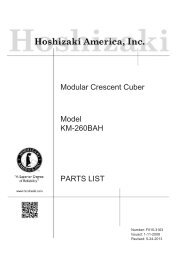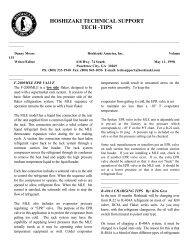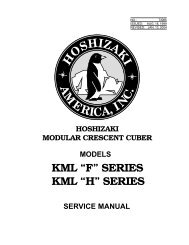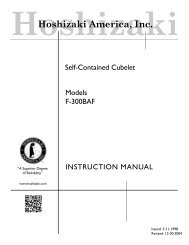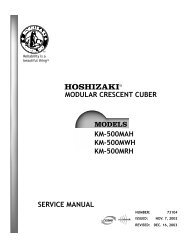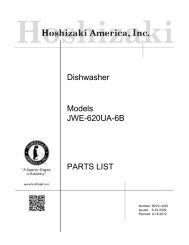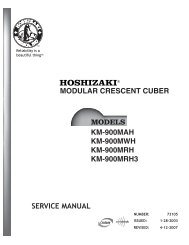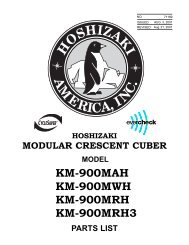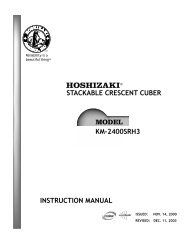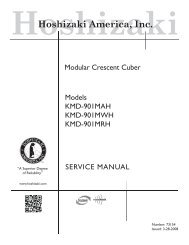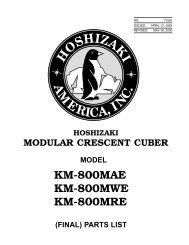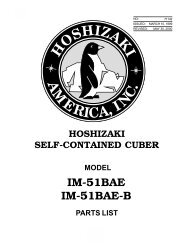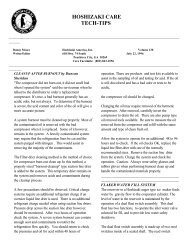HOSHIZAKI CARE TECH-TIPS - Hoshizaki America, Inc.
HOSHIZAKI CARE TECH-TIPS - Hoshizaki America, Inc.
HOSHIZAKI CARE TECH-TIPS - Hoshizaki America, Inc.
You also want an ePaper? Increase the reach of your titles
YUMPU automatically turns print PDFs into web optimized ePapers that Google loves.
<strong>HOSHIZAKI</strong> <strong>CARE</strong><strong>TECH</strong>-<strong>TIPS</strong>___________________________________________________________________________________________________Danny Moore <strong>Hoshizaki</strong> <strong>America</strong>, <strong>Inc</strong>. Volume 124Editor 618 Hwy. 74 South December 5, 1995Peachtree City, GA 30269Care Facsimile: (800) 843-1056___________________________________________________________________________________________________1996 SERVICE SEMINAR UPDATEThe service seminar schedule for the first quarter of1996 has been finalized. We have 90 basic seminarsscheduled across the country. These 3 1/2 hour basicseminars include a service introduction to the KM &Flaker/DCM products. We will provide additionalservice tips on these products and cover the new RH-2reach-in and DM-180 counter top dispenser.The seminar program will shift towards a morediagnostic format. This will arm you with a better serviceknowledge to attack a <strong>Hoshizaki</strong> service call. Contactyour local <strong>Hoshizaki</strong> Distributor for information on the1996 Basic Seminar nearest you.We have also scheduled 7 Advanced Seminars in thistime period. The dates and locations are as follows:January 9,1996 La Mirada, CAJanuary 30,1996 Houston, TXFebruary 13, 1996 Peachtree City, GAFebruary 27, 1996 Elmhurst, ILMarch 12, 1996 N. NJ / NY, NYMarch 26, 1996 Peachtree City, GAApril 23, 1996 Columbus, OHThe Advanced Seminar is a 2 day training sessionon the KM, Flaker, and DCM products. Theoperational sequence, water system, refrigerationsystem and electrical circuits are covered in-depth.<strong>Hoshizaki</strong> provides the training, handouts and mealsduring the seminar. The attendee is responsible fortravel and lodging. To attend, you must have attended abasic seminar within the last two years.The Peachtree City Advanced programs include afactory tour. Additional Advanced programs will beoffered in the fall. Watch for details. To register for anAdvanced program, contact your local <strong>Hoshizaki</strong>Distributor and request a pre-registration form.___________________________________________________________________________________WATER SOFTENER APPLICATIONSHardness in water causes many problems in an icemachine application. The hardness is caused by thepresence of calcium and magnesium ions in the water.These particular ions precipitate out during the icefreezing process and begin to build up as scale on theevaporator and in the reservoir.The amount of hardness in water is expressed in partsper million or as grains of hardness. A grain is equal to1 / 7,000th of a pound per gallon of water.One grain equals 17.1 ppm.When hard water conditions below 300 ppm exist,scale build up can be reduced by several methods.Extending the built-in flush on the KM by adjusting thedefrost completion timer longer will help to flush excessminerals out. There are also many different filter systemsand water treatment devices in the market that will help.When water hardness is 300 ppm or more, scale buildup occurs rapidly inside an ice machine. In a KMcuber, this excess scale build up can be curbed byoperating the cuber on a water softener. Some
manufacturers do not recommend operating their icemachine’s on a water softener. This is not a problemwith the KM design.A typical water softener uses ion exchange as themethod to correct hardness. The minerals used in awater softener have a high sodium content. When thehard water is passed through a softener system, calciumand magnesium ions are exchanged for sodium ions.These sodium ions are flushed out through the pump-outand flush system and do not form scale in the KMcuber.Most talc or softener sediment which may precipitateout during freeze, will be flushed out, however if anexcess exist, you can adjust for a longer flush to helpeliminate it.Excessive talc can show up after a softener is serviced.This is especially true if the softener is over filled or notpurged properly during service. It will show up as heavytalc in the bottom of the reservoir, soft cloudy ice, or aclear coating on the evaporator plates. The coatingreduces heat transfer and can cause ice to stick to theplates, leading to a freeze-up. If the evaporator platesare coated, cleaning with <strong>Hoshizaki</strong> Scale Away isrequired.While water softeners are acceptable on the KM cuber,they should never be used on a Flaker or DCM unit.Remember that softened water contains sodium which issalt. Salt is very abrasive and can cause prematurebearing wear. You will also find that the ice quality andproduction of flaked ice will be affected if softenedwater is used on any auger type machine.____________________________________________________________________________________BIN CONTROL CHANGESOver the years, <strong>Hoshizaki</strong> has made several changes inthe thermostatic bin control used on the KM seriesunits. The bulb and mounting for this thermostaticcontrol is subjected to frequent abuse. Unfortunately thiscontrol bulb must be located in the ice drop zone forproper operation. Ice hitting against the bulb, as wellas a frequent smacks with an ice scoop, takes it’s toll onthe bin control.The improvements we have made have definitelyserved to decrease the bin control failure rate. A newABS mounting bracket is now shipped withreplacement parts. Ranco Controls has also provided uswith a replacement control that has a larger capillary anda larger charging tip. This improvedcontrol is now used on production units.____________________________________________________________________________________COPELAND COMPRESSORSUp to mid 1989, <strong>Hoshizaki</strong> used Toshiba compressorsin KM, F, & DCM units. Since that time, we have usedCopeland compressors in all F & DCM units except theF-250 and DCM-240 models. Copeland compressorsare also used in our KM series up through the KM-1200 model.Standard model Copelaweld compressors are used inthe above applications. You will find importanttechnical data for these standard compressors includedin the Copeland Electrical Handbook. This informationis also provided in Service bulletin SB94-0011 and onthe compressor data page of the Tech- Specs.Over the years, we have had many requests from thefield to provide a Copeland replacement number for theolder Toshiba compressors. Testing to find theappropriate replacements is scheduled. As an update tothe status of this project, Copeland has tested thefollowing compressors and found them equivalent inperformance. The compressor equivalents are :KM-451 Toshiba CL75JD-1U is equivalent toCopeland RSF5-0075-CAA202KM-631 Toshiba KL100JD-3U is equivalent toCopeland REK5-0125-PFV206KM-1201 Toshiba KL187JC-3U is equivalent toCopeland CRE2-0225-PFV230** It is important to note that testing by <strong>Hoshizaki</strong>Engineering Department and approval to use thesereplacements has not been completed at this time.
When final testing is completed, the Care departmentwill have the necessary technical information to assistyou in a conversion from a Toshiba to a Copelandcompressor. We will keep you advised on the status ofthis important project.____________________________________________________________________________________COMING NEXT MONTH...1. Reverse Osmosis2. Compressor Diagnosis3. PM Reminder Volume 124 page 2



